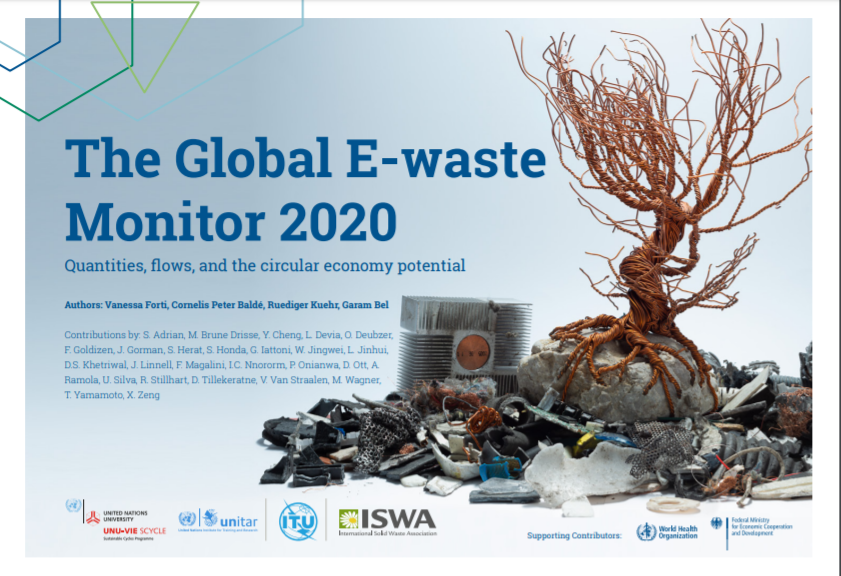In June, the Global E-Waste Statistics Partnership (GESP) released The Global E-waste Monitor 2020, which examined the quantities, flows, and circular economy potential of waste electrical and electronic equipment (WEEE) across the planet. The report also includes national and regional analysis on
e-waste quantities and legislative instruments.

GESP was founded in 2017 by the International Telecommunication Union (ITU), the United Nations University (UNU), and the International Solid Waste Association (ISWA). Its objectives are to monitor developments of e-waste over time, and help countries to produce e-waste statistics, which in turn will inform policymakers, industries, academia, media, and the general public by enhancing the understanding and interpretation of global e-waste data and its relation to the Sustainable Development Goals (SDGs).
According to the report, in 2019, the world generated 53.6 million metric tons (Mt, or Megatoone; see https://ec.europa.eu/eurostat/statistics-explained/index.php/Glossary:Megatonne_(Mt) and http://www.onlineconversion.com/faq_09.htm for explanations on units) of e-waste. This is an average of 7.3 kg (a little over 16 lbs) per capita, and represents a 21% increase in generation within 5 years. Further, the global generation of e-waste grew by 9.2 Mt since 2014 and is projected to grow to 74.7 Mt by 2030–this means the amount of e-waste generated will almost double in only 16 years. Just 17.4% of the e-waste generated in 2019 was officially recycled, through formal recycling programs.
Additional findings include:
- “The fate of 82.6% (44.3 Mt) of e-waste generated in 2019 is uncertain, and its whereabouts and the environmental impact varies across the different regions…In middle- and low-income countries… e-waste is managed mostly by the informal sector.”
- “Since 2014, the number of countries that have adopted a national e-waste policy, legislation, or regulation has increased from 61 to 78.”
- “E-waste contains several toxic additives or hazardous substances, such as mercury, brominated flame retardants (BFR), and chlorofluorocarbons (CFCs), or hydrochlorofluorocarbons (HCFCs). The increasing levels of e-waste, low collection rates, and non-environmentally sound disposal and treatment of this waste stream pose significant risks to the environment and to human health. A total of 50 t of mercury and 71 kt of BFR plastics are found in globally undocumented flows of e-waste annually, which is largely released into the environment and impacts the health of the exposed workers.”
- “Improper management of e-waste also contributes to global warming.” (Note that outside the US, the term “e-waste” or “WEEE” includes electrical equipment, such as air conditioners and refrigerators, which contain refrigerants that are greenhouse gases, whereas in the US, “e-waste” tends to refer to computers and peripherals, cell phones, printers, televisions, and similar electronics.)
- “The value of raw materials in the global e-waste generated in 2019 is equal to approximately $57
billion USD.”
The authors state, “In summary, it is essential to substantially increase the officially documented 17.4% global e-waste collection and recycling rate, especially in view of the rapid growth of this waste stream, which is already projected to reach 74.7 Mt by 2030, combined with increasing recovery of materials towards closed material loops and reducing the use of virgin materials.”
You may download the complete report at https://globalewaste.org/news/surge-global-waste/.
See also this analysis by Justine Calma for The Verge, July 2, 2020: https://www.theverge.com/21309776/record-amount-ewaste-2019-global-report-environment-health. Highlights from this article include:
- “Small electronics — like video cameras, electronic toys, toasters, and electric shavers — made up the biggest chunk of 2019’s e-waste (about 32 percent). The next largest piece of the pie (24 percent) was made up of large equipment like kitchen appliances and copy machines. This group includes discarded solar panels, which aren’t a huge problem yet but could pose issues as the relatively new technology gets older. Screens and monitors created about half as much trash as large equipment but still amounted to close to 7 million metric tons of e-waste in 2019. Small IT and telecommunications equipment like phones added up to about 5 million metric tons of trash.”
- “The growing mounds of e-waste are only getting more complex and more toxic, according to Scott Cassel, who founded the nonprofit Product Stewardship Institute. ‘Electronic companies do a great job of designing for pleasure and efficiency, but the rapid change in consumer demand also means that they’re designing for obsolescence. So today’s newest, coolest product becomes tomorrow’s junk,’ Cassel says.”



 information on the transition process for R2 certified facilities, the development process for the new standard, public comments, and the differences between the previous and new versions of the standard. Highlights of the proposed changes can also be found at
information on the transition process for R2 certified facilities, the development process for the new standard, public comments, and the differences between the previous and new versions of the standard. Highlights of the proposed changes can also be found at 
